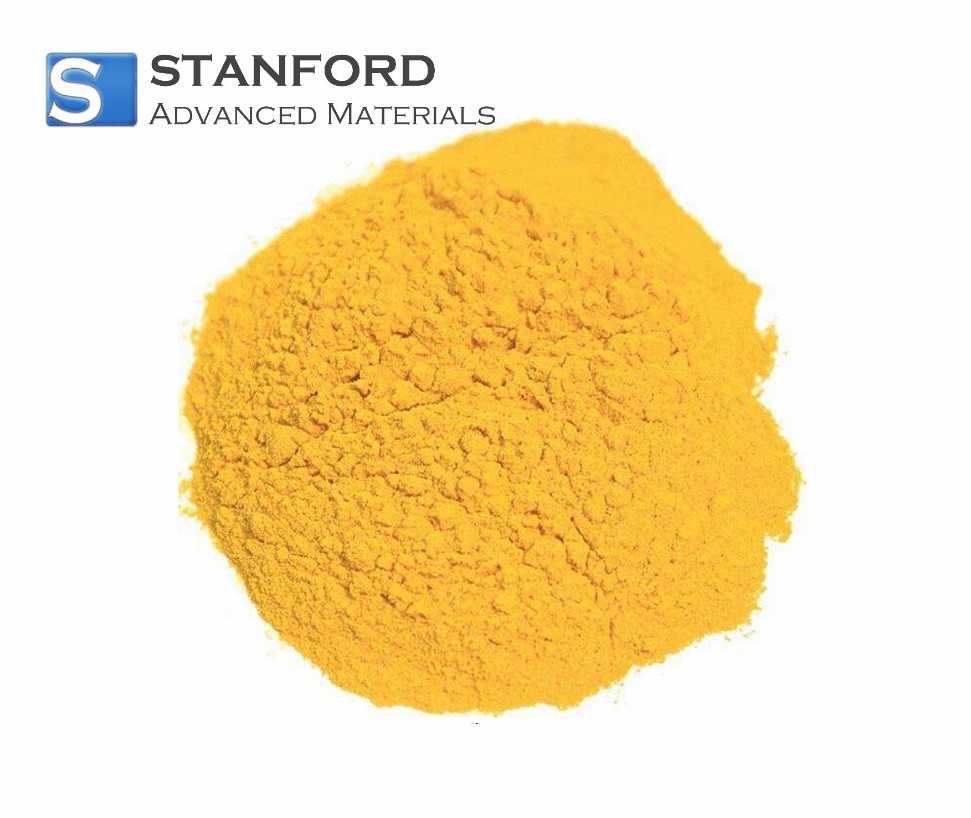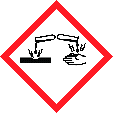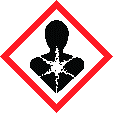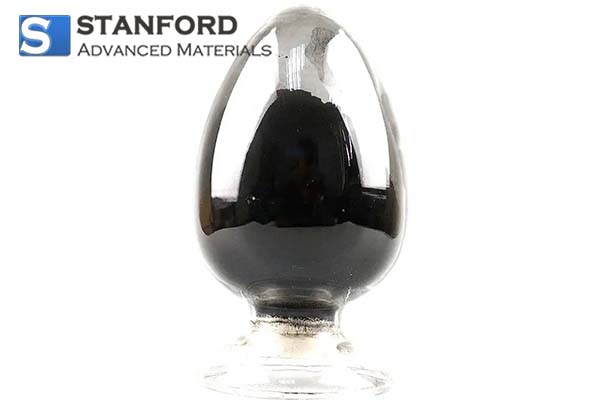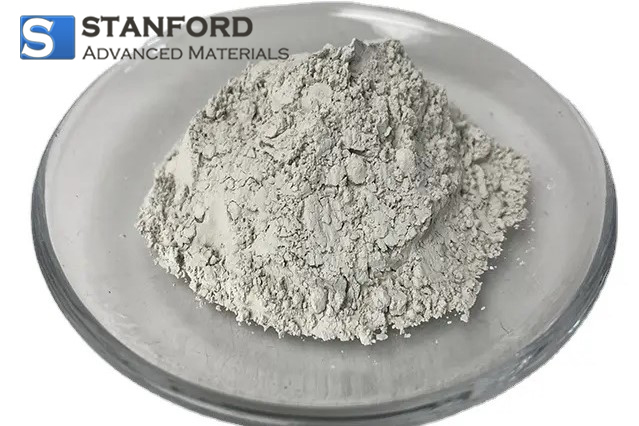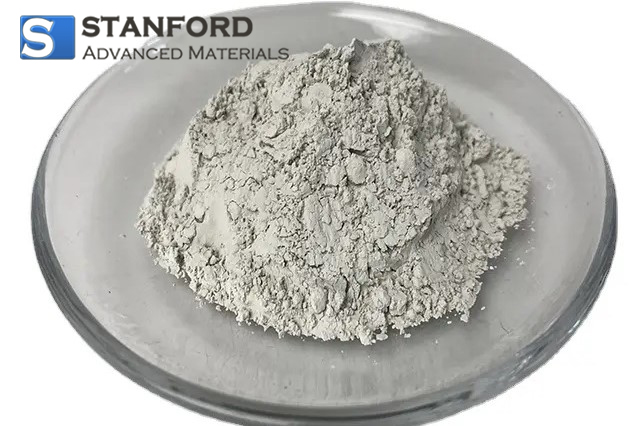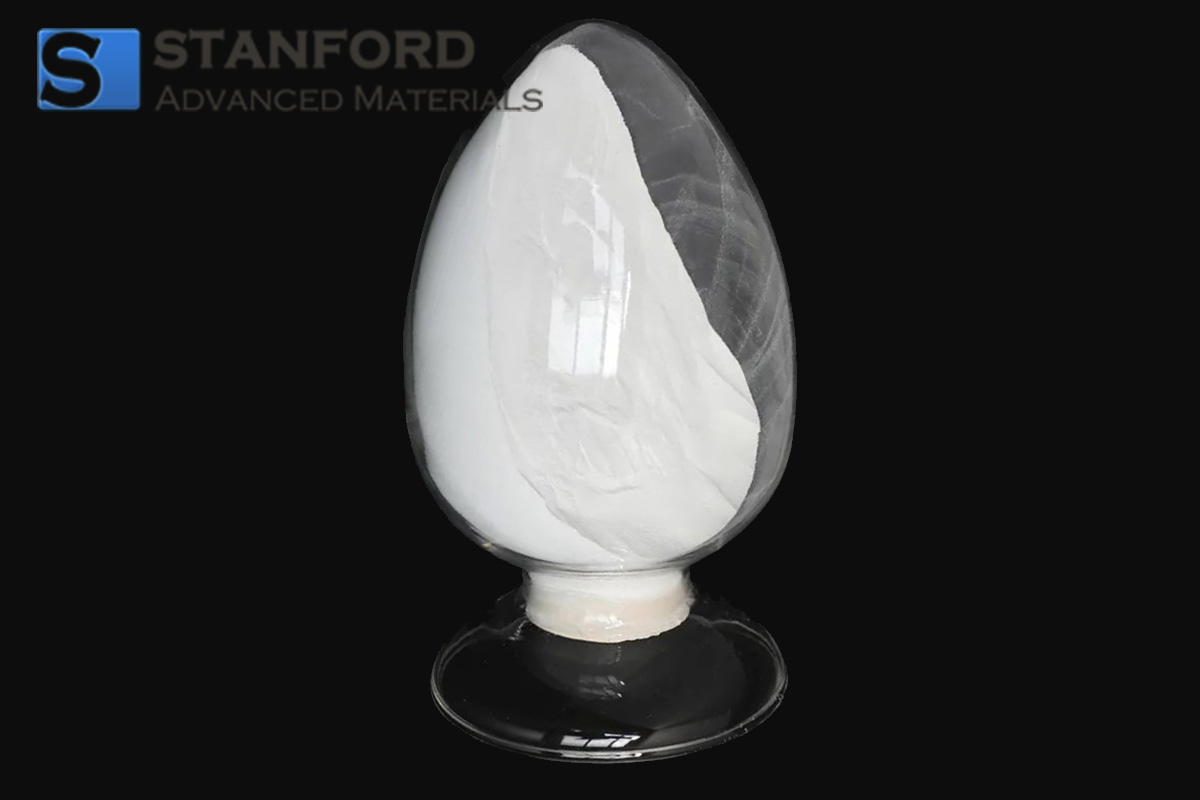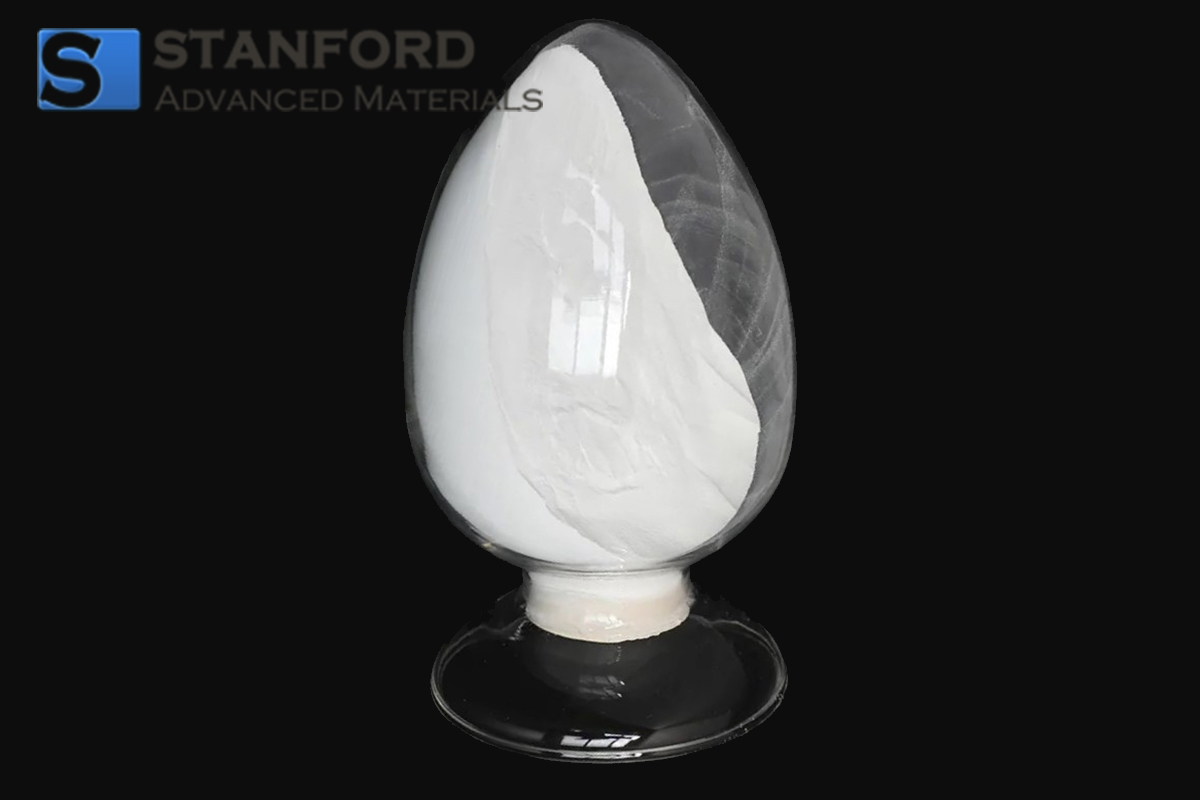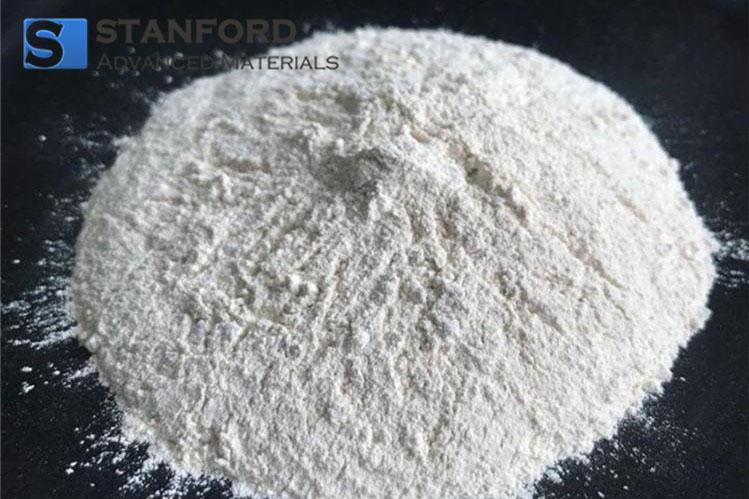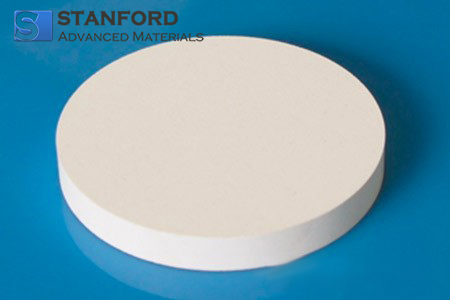SECTION 1. IDENTIFICATION
Product Name: Aluminum Chloride, Anhydrous
CAS #: 7446-70-0
Relevant identified uses of the substance: Scientific research and development
Supplier details:
Stanford Advanced Materials
E-mail: sales@samaterials.com
Tel: (949) 407-8904
Address: 23661 Birtcher Dr., Lake Forest, CA 92630 U.S.A.
SECTION 2. HAZARDS IDENTIFICATION
Classification of the substance or mixture in accordance with 29 CFR 1910 (OSHA HCS)
GHS05 Corrosion
Skin Corr. 1B H314 Causes severe skin burns and eye damage.
Hazards not otherwise classified No data available
GHS label elements, including precautionary statements
Hazard pictograms
GHS05
Signal word Danger
Hazard statements
H314 Causes severe skin burns and eye damage.
Precautionary statements
P260 Do not breathe dust/fume/gas/mist/vapors/spray.
P303+P361+P353 If on skin (or hair): Take off immediately all contaminated clothing. Rinse skin with
water/shower.
P305+P351+P338 IF IN EYES: Rinse cautiously with water for several minutes. Remove contact
lenses, if present and easy to do. Continue rinsing.P301+P330+P331 IF SWALLOWED: rinse mouth. Do NOT induce vomiting.
P405 Store locked up.
P501 Dispose of contents/container in accordance with local/regional/national/international
regulations.
WHMIS classification
D2B - Toxic material causing other toxic effects
E - Corrosive material
Classification system
HMIS ratings (scale 0-4)
(Hazardous Materials Identification System)
HEALTH
FIRE
REACTIVITY
3
0
1
Health (acute effects) = 3
Flammability = 0
Physical Hazard = 1
Other hazards
Results of PBT and vPvB assessment
PBT: N/A
vPvB: N/A
SECTION 3. COMPOSITION/INFORMATION ON INGREDIENTS
Substances
CAS No. / Substance Name:
7446-70-0 Aluminum chloride, anhydrous
Identification number(s):
EC number: 231-208-1
Index number: 013-003-00-7
SECTION 4. FIRST AID MEASURES
Description of first aid measures
General information Immediately remove any clothing soiled by the product.
If inhaled:
Supply patient with fresh air. If not breathing, provide artificial respiration. Keep patient warm.
Seek immediate medical advice.
In case of skin contact:
Immediately wash with soap and water; rinse thoroughly.
Seek immediate medical advice.
In case of eye contact:
Rinse opened eye for several minutes under running water. Consult a physician.
If swallowed:
Seek medical treatment.
Information for doctor
Most important symptoms and effects, both acute and delayed
Causes severe skin burns.
Causes serious eye damage.Indication of any immediate medical attention and special treatment needed:
No data available
SECTION 5. FIREFIGHTING MEASURES
Extinguishing media
Suitable extinguishing agents CO2, sand, extinguishing powder. Do not use water.
For safety reasons unsuitable extinguishing agents Water
Special hazards arising from the substance or mixture
If this product is involved in a fire, the following can be released:
Metal oxide fume
Hydrogen chloride (HCl)
Advice for firefighters
Protective equipment:
Wear self-contained respirator.
Wear fully protective impervious suit.
SECTION 6. ACCIDENTAL RELEASE MEASURES
Personal precautions, protective equipment and emergency procedures
Use personal protective equipment. Keep unprotected persons away.
Ensure adequate ventilation
Environmental precautions: Do not allow material to be released to the environment without official
permits.
Methods and materials for containment and cleanup:
Use neutralizing agent.
Dispose of contaminated material as waste according to section 13.
Ensure adequate ventilation.
Prevention of secondary hazards: No special measures required.
Reference to other sections
See Section 7 for information on safe handling
See Section 8 for information on personal protection equipment.
See Section 13 for disposal information.
SECTION 7. HANDLING AND STORAGE
Handling
Precautions for safe handling
Handle under dry protective gas.
Keep container tightly sealed.
Store in cool, dry place in tightly closed containers.
Ensure good ventilation at the workplace.
Information about protection against explosions and fires: The product is not flammable
Conditions for safe storage, including any incompatibilities
Requirements to be met by storerooms and receptacles: No special requirements.
Information about storage in one common storage facility:
Store away from oxidizing agents.
Store away from strong bases.
Store in the dark.
Store away from water/moisture.Further information about storage conditions:
Store under dry inert gas.
This product is moisture sensitive.
Keep container tightly sealed.
Store in cool, dry conditions in well-sealed containers.
Protect from humidity and water.
Protect from exposure to light.
Specific end use(s) No data available
SECTION 8. EXPOSURE CONTROLS/PERSONAL PROTECTION
Additional information about design of technical systems:
Properly operating chemical fume hood designed for hazardous chemicals and having an average
face velocity of at least 100 feet per minute.
Control parameters
Components with limit values that require monitoring at the workplace:
7446-70-0 Aluminum chloride, anhydrous (100.0%)
REL (USA) Long-term value: 2 mg/m
3
as Al
TLV (USA) Long-term value: 1* mg/m
3
as Al;*as respirable fraction
EL (Canada) Long-term value: 2 mg/m
3
as Al
Additional information: No data
Exposure controls
Personal protective equipment
Follow typical protective and hygienic practices for handling chemicals.
Keep away from foodstuffs, beverages and feed.
Remove all soiled and contaminated clothing immediately.
Wash hands before breaks and at the end of work.
Avoid contact with the eyes and skin.
Maintain an ergonomically appropriate working environment.
Breathing equipment: Use suitable respirator when high concentrations are present.
Use a respirator with type P100 (USA) or P3 (EN 143) cartridges as a backup to engineering controls.
Risk assessment should be performed to determine if airpurifying
respirators are appropriate. Only use equipment tested and approved under appropriate government
standards.
Protection of hands:
Impervious gloves
Inspect gloves prior to use.
The selection of suitable gloves not only depends on the material, but also on quality. Quality will vary
from manufacturer to manufacturer.
Material of gloves Nitrile rubber, NBR
Penetration time of glove material (in minutes) 480
Glove thickness 0.11 mm
Eye protection:
Tightly sealed goggles
Full face protection
Body protection: Protective work clothing.
SECTION 9. PHYSICAL AND CHEMICAL PROPERTIES
Information on basic physical and chemical properties
Appearance:
Form: Powder or granules
Color: Yellow to gray
Odor: Pungent
Odor threshold: No data available.
pH (100 g/l) at 20 °C (68 °F): 2.4
Melting point/Melting range: 190 °C (374 °F) (subl)
Boiling point/Boiling range: No data available
Sublimation temperature / start: No data available
Flammability (solid, gas) No data available.
Ignition temperature: No data available
Decomposition temperature: No data available
Autoignition: No data available.
Danger of explosion: No data available.
Explosion limits:
Lower: No data available
Upper: No data available
Vapor pressure at 20 °C (68 °F): 0.00003 hPa
Density at 20 °C (68 °F): 2.44 g/cm
3
(20.362 lbs/gal)
Relative density No data available.
Vapor density N/A
Evaporation rate N/A
Solubility in / Miscibility with
Water: Reacts with water forming hydrochloric acid (HCl)
Partition coefficient (n-octanol/water): No data available.
Viscosity:
Dynamic: N/A
Kinematic: N/A
Other information No data available
SECTION 10. STABILITY AND REACTIVITY
Reactivity No data available
Chemical stability Stable under recommended storage conditions.
Thermal decomposition / conditions to be avoided: Decomposition will not occur if used and stored
according to specifications.
Possibility of hazardous reactions Reacts with water forming hydrochloric acid (HCl)
Conditions to avoid No data available
Incompatible materials:
Bases
Water/moisture
Light
Hazardous decomposition products:
Metal oxide fume
Hydrogen chloride (HCl)
SECTION 11. TOXICOLOGICAL INFORMATION
Information on toxicological effects
Acute toxicity:
Swallowing will lead to a strong corrosive effect on mouth and throat and to the danger of perforation
of esophagus and stomach.
The Registry of Toxic Effects of Chemical Substances (RTECS) contains acute toxicity data for
components in this product.
LD/LC50 values that are relevant for classification:
Oral LD50 1130 mg/kg (mouse)
3450 mg/kg (rat)
Dermal LD50 >2 gm/kg (rabbit)
Skin irritation or corrosion: Causes severe skin burns.
Eye irritation or corrosion: Causes serious eye damage.
Sensitization: No sensitizing effects known.
Germ cell mutagenicity: The Registry of Toxic Effects of Chemical Substances (RTECS) contains
mutation data for this substance.
Carcinogenicity: No classification data on carcinogenic properties of this material is available from the
EPA, IARC, NTP, OSHA or ACGIH.
Reproductive toxicity: The Registry of Toxic Effects of Chemical Substances (RTECS) contains
reproductive data for this substance.
Specific target organ system toxicity - repeated exposure: No effects known.
Specific target organ system toxicity - single exposure: No effects known.
Aspiration hazard: No effects known.
Subacute to chronic toxicity: No effects known.
Additional toxicological information: To the best of our knowledge the acute and chronic toxicity of this
substance is not fully known.
SECTION 12. ECOLOGICAL INFORMATION
Toxicity
Aquatic toxicity: No data available
Persistence and degradability No data available
Bioaccumulative potential No data available
Mobility in soil No data available
Additional ecological information:
Do not allow material to be released to the environment without official permits.
Do not allow undiluted product or large quantities to reach groundwater, water courses, or sewage
systems.
Avoid transfer into the environment.
Results of PBT and vPvB assessment
PBT: N/A
vPvB: N/A
Other adverse effects No data available
SECTION 13. DISPOSAL CONSIDERATIONS
Waste treatment methods
Recommendation Consult official regulations to ensure proper disposal.
Uncleaned packagings:
Recommendation: Disposal must be made according to official regulations.
SECTION 14. TRANSPORT INFORMATION
DOT, IMDG, IATA UN1726
UN proper shipping name
DOT Aluminum chloride, anhydrous
IMDG, IATA ALUMINIUM CHLORIDE, ANHYDROUS
Transport hazard class(es)
DOT
Class 8 Corrosive substances.
Label 8
Class 8 (C2) Corrosive substances
Label 8
IMDG, IATA
Class 8 Corrosive substances.
Label 8
Packing group
DOT, IMDG, IATA II
Environmental hazards: N/A
Special precautions for user Warning: Corrosive substances
EMS Number: F-A,S-B
Segregation groups Acids
Transport in bulk according to Annex II of MARPOL73/78 and the IBC Code N/A
Transport/Additional information:
DOT
Marine Pollutant (DOT): No
UN "Model Regulation": UN1726, Aluminum chloride, anhydrous, 8, II
SECTION 15. REGULATORY INFORMATION
Safety, health and environmental regulations/legislation specific for the substance or mixture
GHS label elements, including precautionary statements
Hazard pictograms
GHS05
Signal word Danger
Hazard statements
H314 Causes severe skin burns and eye damage.
Precautionary statements
P260 Do not breathe dust/fume/gas/mist/vapors/spray.
P303+P361+P353 If on skin (or hair): Take off immediately all contaminated clothing. Rinse skin with
water/shower.
P305+P351+P338 IF IN EYES: Rinse cautiously with water for several minutes. Remove contact
lenses, if present and easy to do. Continue rinsing.
P301+P330+P331 IF SWALLOWED: rinse mouth. Do NOT induce vomiting.
P405 Store locked up.
P501 Dispose of contents/container in accordance with local/regional/national/international
regulations.
National regulations
All components of this product are listed in the U.S. Environmental Protection Agency Toxic
Substances Control Act Chemical substance Inventory.
All components of this product are listed on the Canadian Domestic Substances List (DSL).
SARA Section 313 (specific toxic chemical listings) Substance is not listed.California Proposition 65
Prop 65 - Chemicals known to cause cancer Substance is not listed.
Prop 65 - Developmental toxicity Substance is not listed.
Prop 65 - Developmental toxicity, female Substance is not listed.
Prop 65 - Developmental toxicity, male Substance is not listed.
Information about limitation of use: For use only by technically qualified individuals.
Other regulations, limitations and prohibitive regulations
Substance of Very High Concern (SVHC) according to the REACH Regulations (EC) No. 1907/2006.
Substance is not listed.
The conditions of restrictions according to Article 67 and Annex XVII of the Regulation (EC) No
1907/2006 (REACH) for the manufacturing, placing on the
market and use must be observed.
Substance is not listed.
Annex XIV of the REACH Regulations (requiring Authorisation for use) Substance is not listed.
Chemical safety assessment: A Chemical Safety Assessment has not been carried out.
SECTION 16. OTHER INFORMATION
Safety Data Sheet according to Regulation (EC) No. 1907/2006 (REACH). The above information is
believed to be correct but does not purport to be all inclusive and shall be used only as a guide. The
information in this document is based on the present state of our knowledge and is applicable to the
product with regard to appropriate safety precautions. It does not represent any guarantee of the
properties of the product.


 English
English Española
Española Deutsch
Deutsch Français
Français Italiano
Italiano